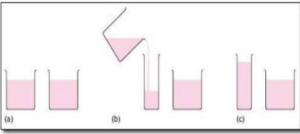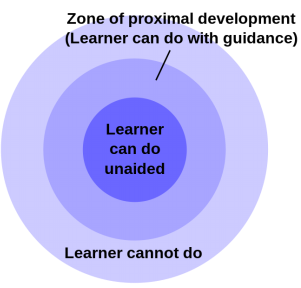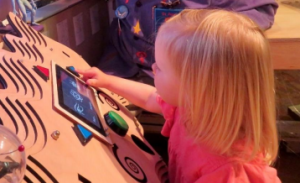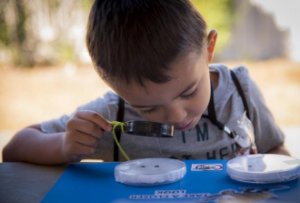3 Cognitive Development in the Preschool Years
Chapter Objectives
After this chapter, you should be able to:
- Compare and contrast Piaget and Vygotsky’s beliefs about cognitive development.
- Explain the role of information processing in cognitive development.
- Discuss how preschool-aged children understand their worlds.
- Put cognitive milestones into the order in which they appear in typically developing children. Discuss how early child education supports development and how our understanding of development influence education.
- Describe autism spectrum disorder as atypical cognitive development
Introduction
Understanding of cognitive development is advancing on many different fronts. One exciting area is linking changes in brain activity to changes in children’s thinking (Nelson et al., 2006, as cited in Leon, n.d.). Although many people believe that brain maturation is something that occurs before birth, the brain actually continues to change in large ways for many years thereafter. For example, a part of the brain called the prefrontal cortex, which is located at the front of the brain and is particularly involved with planning and flexible problem solving, continues to develop throughout adolescence (Blakemore & Choudhury, 2006, as cited in Leon, n.d.).
preschool cognitive skills
The Continuum of Development (Ontario Ministry of Education, 2014) describes the core skills which are part of the preschool/ kindergarten stage of development. These skills are also reflected the overall and specific expectations in the four frames in Ontario’s the Kindergarten Program (Ontario Ministry of Education, 2016). This document will be referred to throughout the chapters on preschool development.
Below is a summary of the core skills in preschool cognitive development as described in the Continuum of Development by Ontario Ministry of Education (2014).
During the preschool years children continue to observe their world, ask questions, and develop and test their theories about how things work. During this stage of development children master new ways of describing and making meaning of their experiences. At this stage their reasoning is more logical. They solve problems by collecting and organizing information, reflecting on it, drawing conclusions and communicating their findings with others. This may include the skills of classifying and seriating. Increased verbal abilities allow them to use spatial terms and positional words such as behind, inside, in front of, between. They can follow directions, creating and using maps.
Preschoolers’ exploration of mathematics continues to grow with an increasing understanding of numeracy, which includes counting in meaningful ways to determine quantity, comparing quantities, and completing simple number operations using number symbols. They explore ways to represent number such as tally marks. They demonstrate a growing ability to describe attributes of 2 dimensional figures and 3 dimensional solids, to identify patterns and show an interest in measurement, particularly linear measurement. They become more skilled at understanding time and how it is measured.
The ability to represent is demonstrated through using materials to express ideas which may be in the form of 2D and 3D creations. In socio dramatic play preschoolers can take on a role pretending to be someone else, sustaining the play, and using props to tell a story. (Ontario Ministry of Education, 2014)
Early childhood is a time of pretending, blending fact and fiction, and learning to think of the world using language. As young children move away from needing to touch, feel, and hear about the world toward learning some basic principles about how the world works, they hold some interesting ideas. For example, while adults have no concerns with taking a bath, a child of three might genuinely worry about being sucked down the drain. A child might protest if told that something will happen “tomorrow” but be willing to accept an explanation that an event will occur “today after we sleep.” Or the young child may ask, “How long are we staying? From here to here?” while pointing to two points on a table. Concepts such as tomorrow, time, size and distance are not easy to grasp at this young age. Understanding size, time, distance, fact and fiction are all tasks that are part of cognitive development in the preschool years.
Piaget’s Preoperational Intelligence
Piaget’s stage that coincides with early childhood is the preoperational stage. The word operational means logical, children are learning to use language and to think about the world symbolically. Let’s examine some of Piaget’s assertions about children’s cognitive abilities at this age.
Mental representation
As children move through substage 6 in sensorimotor development they begin to work with symbols, words ,and gestures to form an internal working model of their world. They demonstrate deferred imitation by imitating actions they have seen at a previous time. They begin to use objects to represent other things so a block can be a phone for example. These new skills support the emergence of make-believe play.
Pretend play
Pretending is a favourite activity at this time. A toy has qualities beyond the way it was designed to function and can now be used to stand for a character or object unlike anything originally intended. A teddy bear, for example, can be a baby or the queen of a faraway land!

Figure 10.1: A child pretending to buy items at a toy grocery store. (Image by Ermalfaro is licensed under CC BY-SA 4.0)
According to Piaget, children’s pretend play helps them solidify new schemes they were developing cognitively. This play, then, reflects changes in their conceptions or thoughts. However, children also learn as they take on roles. examine perspectives, pretend and experiment. Their play does not simply represent what they have learned (Berk, 2007, as cited Paris, Ricardo, Raymond, & Johnson, 2021). In their play they make meaning of their lived experiences and explore possibilities as they consider ‘what is’ and ‘what if’?
Indigenous Perspectives
This is the perfect age to introduce Indigenous Storytelling with role playing the animals in the story. Let them change the story and have fun with it. Children will see themselves in the story. This relates to what Piaget says: “In their play, they make meaning of their lived experiences and explore possibilities as they consider ‘what is’ and ‘what if’?”. Plenty of outdoor play will help to connect children to the land.
At this age, children also have to have clear directions in order to complete what they are asked to do. For example, if the child is not looking at you. You say listen to me. The child says “I am listening to you.” The educator has to be precise in what they are asking of the child. It is important to note that a lot of Indigenous children might not look you in the eyes. This is a cultural thing.
Egocentrism
Egocentrism in early childhood refers to the tendency of young children to think that everyone sees things in the same way as the child. Piaget’s classic experiment on egocentrism involved showing children a 3-dimensional model of a mountain and asking them to describe what a doll that is looking at the mountain from a different angle might see. Children tend to choose a picture that represents their own view, rather than that of the doll. However, children tend to use different sentence structures and vocabulary when addressing a younger child or an older adult. This indicates some awareness of the views of others.

Figure 10.2: Piaget’s egocentrism experiment. (Image by Rosenfeld Media is licensed under CC BY 2.0)
Syncretism
Syncretism refers to a tendency to think that if two events occur simultaneously, one caused the other. Example: A family is planning to go on a picnic. The preschooler misbehaves by taking a toy away from their younger sibling who cries. The family reacts firmly to the situation. As they are sorting out the situation, they hear the sound of distant thunder and decide to postpone the picnic. The preschooler may believe that their behaviour caused the storm which resulted in the cancellation of the plans.
Animism
Attributing lifelike qualities to objects is referred to as animism. The cup is alive, the chair that falls down and hits the child’s ankle is mean, and the toys need to stay home because they are tired. Cartoons and animation frequently show objects that appear alive and take on lifelike qualities. They may also think that a small gardening tool could grow up to be a full-size shovel. Young children do seem to think that objects that move may be alive but after age 3, they seldom refer to objects as being alive (Berk, 2007, as cited in Paris, Ricardo, Raymond, & Johnson, 2021).
Classification Errors
Preoperational children have difficulty understanding that an object can be classified in more than one way. For example, if shown three white buttons and four black buttons and asked whether there are more black buttons or buttons, the child is likely to respond that there are more black buttons. As the child’s vocabulary improves and more schemes are developed, the ability to classify objects improves.
Conservation Errors
Conservation refers to the ability to recognize that moving or rearranging matter does not change the quantity. Let’s look at an example. A father gave a slice of pizza to 10-year-old Keiko and another slice to 3-year-old Kenny. Kenny’s pizza slice was cut into five pieces, so Kenny told his sister that he got more pizza than she did. Kenny did not understand that cutting the pizza into smaller pieces did not increase the overall amount. This was because Kenny exhibited Centration or focused on only one characteristic or attribute of an object to the exclusion of others.
Kenny focused on the five pieces of pizza to his sister’s one piece even though the total amount of pizza was the same. Keiko was able to consider several characteristics of an object rather than just one.
The classic Piagetian experiment associated with conservation involves liquid (Crain, 2005, as cited in Paris, Ricardo, Raymond, & Johnson, 2021). As seen below, the child is shown two glasses (as shown in a) which are filled to the same level and asked if they have the same amount. Usually, the child agrees they have the same amount. The researcher then pours the liquid from one glass to a taller and thinner glass (as shown in b). The child is again asked if the two glasses have the same amount of liquid. The preoperational child will typically say the taller glass now has more liquid because it is taller. The child has concentrated on the height of the glass and fails to conserve (Lally & Valentine-French, 2019).

Figure 10.3: Piagetian liquid conservation experiments. (Image by Martha Lally and Suzanne Valentine-French is licensed under CC BY-NC-SA 3.0)
Cognitive Schemas
As introduced in the first chapter, Piaget believed that in a quest for cognitive equilibrium, we use schemas (categories of knowledge) to make sense of the world. And when new experiences fit into existing schemas, we use assimilation to add that new knowledge to the schema. But when new experiences do not match an existing schema, we use accommodation to add a new schema. During early childhood, children use accommodation often as they build their understanding of the world around them.
Vygotsky’s Sociocultural Theory of Development
Zone of Proximal Development and Scaffolding
Vygotsky’s best-known concept is the zone of proximal development (ZPD). Vygotsky stated that children should be taught in the ZPD, which occurs when they can perform a task with assistance, but not quite yet on their own. With the right kind of teaching, however, they can accomplish it successfully. A good teacher identifies a child’s ZPD and helps the child stretch beyond it. Then the adult (teacher) gradually withdraws support until the child can then perform the task unaided. Researchers have applied the metaphor of scaffolds (the temporary platforms on which construction workers stand) to this way of teaching. Scaffolding is the temporary support that parents or teachers give a child to do a task.

Figure 10.4: Zone of proximal development. (Image by Dcoetzee is licensed under CC0 1.0)
Private Speech
Do you ever talk to yourself? Why? Chances are, this occurs when you are struggling with a problem, trying to remember something, or feel very emotional about a situation. Children talk to themselves too. Piaget interpreted this as egocentric speech or a practice engaged in because of a child’s inability to see things from another’s point of view. Vygotsky, however, believed that children talk to themselves in order to solve problems or clarify thoughts. As children learn to think in words, they do so aloud before eventually closing their lips to engage in private speech or inner speech.
Thinking out loud eventually becomes thought accompanied by internal speech, and talking to oneself becomes a practice only engaged in when we are trying to learn something or remember something. This inner speech is not as elaborate as the speech we use when communicating with others (Vygotsky, 1962, as cited in Paris, Ricardo, Raymond, & Johnson, 2021).
Contrast with Piaget
Piaget was highly critical of teacher-directed instruction, believing that teachers who take control of the child’s learning place the child into a passive role (Crain, 2005, as cited in Paris, Ricardo, Raymond, & Johnson, 2021). Further, teachers may present abstract ideas without the child’s true understanding, and instead they just repeat back what they heard. Piaget believed children must be given opportunities to discover concepts on their own. As previously stated, Vygotsky did not believe children could reach a higher cognitive level without instruction from more learned individuals. Who is correct? Both theories certainly contribute to our understanding of how children learn.
Information Processing
Information processing researchers have focused on several issues in cognitive development for this age group, including improvements in attention skills, changes in the capacity, and the emergence of executive functions in working memory. Additionally, in early childhood memory strategies, memory accuracy, and autobiographical memory emerge. Early childhood is seen by many researchers as a crucial time period in memory development (Posner & Rothbart, 2007, as cited in Paris, Ricardo, Raymond, & Johnson, 2021).
 input -> processor -> storage -> output -> information” width=”300″ height=”81″>
input -> processor -> storage -> output -> information” width=”300″ height=”81″>
Figure 10.5: How information is processed. (Image by Gradient drift is in the public domain)
attention
Changes in attention have been described by many as the key to changes in human memory (Nelson & Fivush, 2004; Posner & Rothbart, 2007, as cited in Paris, Ricardo, Raymond, & Johnson, 2021). However, attention is not a unified function; it is comprised of sub-processes. The ability to switch our focus between tasks or external stimuli is called divided attention or multitasking. This is separate from our ability to focus on a single task or stimulus, while ignoring distracting information, called selective attention. Different from these is sustained attention, or the ability to stay on task for long periods of time. Moreover, we also have attention processes that influence our behaviour and enable us to inhibit a habitual or dominant response, and others that enable us to distract ourselves when upset or frustrated.
Selective Attention
Children’s ability with selective attention tasks, improve as they age. However, this ability is also greatly influenced by the child’s temperament (Rothbart & Rueda, 2005, as cited Paris, Ricardo, Raymond, & Johnson, 2021), the complexity of the stimulus or task (Porporino, Shore, Iarocci & Burack, 2004), and whether the stimuli are visual or auditory (Guy, Rogers & Cornish, 2013, as cited in Paris, Ricardo, Raymond, & Johnson, 2021). Guy et al. (2013, as cited in Paris, Ricardo, Raymond, & Johnson, 2021) found that children’s ability to selectively attend to visual information outpaced that of auditory stimuli. This may explain why young children are not able to hear the voice of the teacher over the cacophony of sounds in the typical preschool classroom (Jones, Moore & Amitay, 2015, as cited in Paris, Ricardo, Raymond, & Johnson, 2021). Jones and his colleagues found that 4- to 7-year-olds could not filter out background noise, especially when its frequencies were close in sound to the target sound. In comparison, 8- to 11-year-old children often performed similar to adults.

Figure 10.6: A child playing a game that measures their sustained attention. (Image by Fabrice Florin is licensed under CC BY-SA 2.0)
Memory
Based on studies of adults, people with amnesia, and neurological research on memory, researchers have proposed several “types” of memory (see Figure 4.14). Sensory memory (also called the sensory register) is the first stage of the memory system, and it stores sensory input in its raw form for a very brief duration; essentially long enough for the brain to register and start processing the information. Studies of auditory sensory memory show that it lasts about one second in 2-year-olds, two seconds in 3-year-olds, more than two seconds in 4-year-olds, and three to five seconds in 6-year-olds (Glass, Sachse, & von Suchodoletz, 2008, as cited in Paris, Ricardo, Raymond, & Johnson, 2021). Other researchers have also found that young children hold sounds for a shorter duration than do older children and adults, and that this deficit is not due to attentional differences between these age groups, but reflects differences in the performance of the sensory memory system (Gomes et al., 1999, as cited in Paris, Ricardo, Raymond, & Johnson, 2021). The second stage of the memory system is called short-term or working memory. Working memory is the component of memory in which current conscious mental activity occurs.
Working memory often requires conscious effort and adequate use of attention to function effectively. As you read earlier, children in this age group struggle with many aspects of attention and this greatly diminishes their ability to consciously juggle several pieces of information in memory. The capacity of working memory, that is the amount of information someone can hold in consciousness, is smaller in young children than in older children and adults. The typical adult and teenager can hold a 7-digit number active in their short-term memory. The typical 5-year-old can hold only a 4-digit number active. This means that the more complex a mental task is, the less efficient a younger child will be in paying attention to, and actively processing, information in order to complete the task.
Changes in attention and the working memory system also involve changes in executive function. Executive function (EF) refers to self-regulatory processes, such as the ability to inhibit a behaviour or cognitive flexibility, that enable adaptive responses to new situations or to reach a specific goal. Executive function skills gradually emerge during early childhood and continue to develop throughout childhood and adolescence. Like many cognitive changes, brain maturation, especially the prefrontal cortex, along with experience influence the development of executive function skills.
A child shows higher executive functioning skills when the parents are more warm and responsive, use scaffolding when the child is trying to solve a problem, and provide cognitively stimulating environments for the child (Fay-Stammbach, Hawes & Meredith, 2014, as cited in Paris, Ricardo, Raymond, & Johnson, 2021). For instance, scaffolding was positively correlated with greater cognitive flexibility at age two and inhibitory control at age four (Bibok, Carpendale & Müller, 2009, as cited in Paris, Ricardo, Raymond, & Johnson, 2021). In Schneider, Kron-Sperl and Hunnerkopf’s (2009, as cited in Paris, Ricardo, Raymond, & Johnson, 2021) longitudinal study of 102 kindergarten children, the majority of children used no strategy to remember information, a finding that was consistent with previous research. As a result, their memory performance was poor when compared to their abilities as they aged and started to use more effective memory strategies.
The third component in memory is long-term memory, which is also known as permanent memory. A basic division of long- term memory is between declarative and non-declarative memory. Declarative memories, sometimes referred to as explicit memories, are memories for facts or events that we can consciously recollect. Declarative memory is further divided into semantic and episodic memory. Semantic memories are memories for facts and knowledge that are not tied to a timeline, episodic memories are tied to specific events in time. Non- declarative memories, sometimes referred to as implicit memories, are typically automated skills that do not require conscious recollection.
Neo-Piagetians
As previously discussed, Piaget’s theory has been criticized on many fronts, and updates to reflect more current research have been provided by the Neo-Piagetians, or those theorists who provide “new” interpretations of Piaget’s theory. Morra, Gobbo, Marini and Sheese (2008, as cited in Paris, Ricardo, Raymond, & Johnson, 2021) reviewed Neo-Piagetian theories, which were first presented in the 1970s, and identified how these “new” theories combined Piagetian concepts with those found in Information Processing. Similar to Piaget’s theory, Neo- Piagetian theories believe in constructivism, assume cognitive development can be separated into different stages with qualitatively different characteristics, and advocate that children’s thinking becomes more complex in advanced stages. Unlike Piaget, Neo-Piagetians believe that aspects of information processing change the complexity of each stage, not logic as determined by Piaget.
Neo-Piagetians propose that working memory capacity is affected by biological maturation, and therefore restricts young children’s ability to acquire complex thinking and reasoning skills. Increases in working memory performance and cognitive skills development coincide with the timing of several neurodevelopmental processes. These include myelination, axonal and synaptic pruning, changes in cerebral metabolism, and changes in brain activity (Morra et al., 2008, as cited in Paris, Ricardo, Raymond, & Johnson, 2021).
Myelination especially occurs in waves between birth and adolescence, and the degree of myelination in particular areas explain the increasing efficiency of certain skills. Therefore, brain maturation, which occurs in spurts, affects how and when cognitive skills develop. Additionally, all Neo-Piagetian theories support that experience and learning interact with biological maturation in shaping cognitive development (Lally & Valentine-French, 2019).
Children’s Understanding of the World
Both Piaget and Vygotsky believed that children actively try to understand the world around them. More recently developmentalists have added to this understanding by examining how children organize information and develop their own theories about the world.
Theory-Theory
The tendency of children to generate theories to explain everything they encounter is called theory-theory. This concept implies that humans are naturally inclined to find reasons and generate explanations for why things occur. Children frequently ask questions about what they see or hear around them. When the answers provided do not satisfy their curiosity or are too complicated for them to understand, they generate their own theories. In much the same way that scientists construct and revise their theories, children do the same with their intuitions about the world as they encounter new experiences (Gopnik & Wellman, 2012, as cited in Paris, Ricardo, Raymond, & Johnson, 2021). One of the theories they start to generate in early childhood centers on the mental states; both their own and those of others.

Figure 10.7: What theories might this boy be creating? (Image by Eglin Air Force Base is in the public domain)
Theory of Mind
Theory of mind refers to the ability to think about other people’s thoughts. This mental mind reading helps humans to understand and predict the reactions of others, thus playing a crucial role in social development. One common method for determining if a child has reached this mental milestone is the false belief task, described below.
The research began with a clever experiment by Wimmer and Perner (1983, as cited in Paris, Ricardo, Raymond, & Johnson, 2021), who tested whether children can pass a false-belief test (see Figure 4.17). The child is shown a picture story of Sally, who puts a ball in a basket and leaves the room. While Sally is out of the room, Anne comes along and takes the ball from the basket and puts it inside a box. The child is then asked where Sally thinks the ball is located when Sally comes back to the room. Will they look first in the box or in the basket? The right answer is that they will look in the basket, because that’s where Sally put it and thinks it is; but we have to infer this false belief against our own better knowledge that the ball is in the box.

Figure 10.8: A ball. (Image is in the public domain)

Figure 10.9: A basket. (Image is in the public domain)

Figure 10.10: A box. (Image is licensed under CC0)
This is very difficult for children before the age of four because of the cognitive effort it takes. Three-year-olds have difficulty distinguishing between what they once thought was true and what they now know to be true. They feel confident that what they know now is what they have always known (Birch & Bloom, 2003, as cited in Paris, Ricardo, Raymond, & Johnson, 2021). Even adults need to think through this task (Epley, Morewedge, & Keysar, 2004, as cited in Paris, Ricardo, Raymond, & Johnson, 2021).
To be successful at solving this type of task the child must separate what they “know” to be true from what someone else might “think” is true. In Piagetian terms, they must give up a tendency toward egocentrism. The child must also understand that what guides people’s actions and responses are what they “believe” rather than what is reality. In other words, people can mistakenly believe things that are false and will act based on this false knowledge. Consequently, prior to age four children are rarely successful at solving such a task (Wellman, Cross & Watson, 2001, as cited in Paris, Ricardo, Raymond, & Johnson, 2021). Researchers examining the development of theory of mind have been concerned by the overemphasis on the mastery of false belief as the primary measure of whether a child has attained theory of mind. Wellman and his colleagues (Wellman, Fang, Liu, Zhu & Liu, 2006, as cited in Paris, Ricardo, Raymond, & Johnson, 2021) suggest that theory of mind is comprised of a number of components, each with its own developmental timeline (see Table 4.2).
Two-year-olds understand the diversity of desires, yet as noted earlier it is not until age four or five that children grasp false belief, and often not until middle childhood do they understand that people may hide how they really feel. In part, because children in early childhood have difficulty hiding how they really feel.
This awareness of the existence of theory of mind is part of social intelligence, such as recognizing that others can think differently about situations. It helps us to be self-conscious or aware that others can think of us in different ways and it helps us to be able to be understanding or be empathetic toward others. Moreover, this mind-reading ability helps us to anticipate and predict people’s actions. The awareness of the mental states of others is important for communication and social skills (Lally & Valentine-French, 2019).
The many theories of cognitive development and the different research that has been done about how children understand the world has allowed researchers to study the milestones that children who are typically developing experience in early childhood. Understanding how children think and learn has proven useful for improving education.
In 2010, Ontario introduced the full day kindergarten program which was fully implemented by 2014. Children can attend the program at 3 years 8 month of age. There is a year one and a year two of the program. In 2016 The Kindergarten Program document was released describing a play-based curriculum which includes four frames to guide teaching, learning and assessment of learning. Overall and specific expectations are described in each of the four frames.
The frames are:
- Self-regulation and Well-Being
- Belonging and Contributing
- Problem Solving and Innovating
- Demonstrating Literacy and Mathematics Behaviours
In each kindergarten classroom an RECE and a qualified teacher registered with the Ontario College of Teachers (OCT) work in partnership as an educator team to implement the curriculum. There is an expectation for the educator team to observe children’s play, ‘notice and name’ the learning and assess individual progress against the Overall and Specific Expectations. The progress is formally shared with families as their child moves through Year One and Year Two of the Kindergarten Program. In the delivery of the curriculum the educator team provides opportunities for children to demonstrate the expectations, and design and implement learning opportunities specifically related to the expectations. Two of the four frames; Problem Solving and Innovating and Demonstrating Literacy and Mathematics Behaviours relate directly to children’s cognitive development. In the latter frame children are expected to, for example, use language to communicate their thinking and to solve problems, to demonstrate an interest in writing and reading, to demonstrate cardinality and the ability to subitize, to describe the properties of three-dimensional solids and to identify, create and describe simple patterns in mathematical terms (Ontario Ministry of Education, 2016).
Application of “The Kindergarten Program” to the Early Years
Even before they enter kindergarten, the mathematical knowledge of children from low-income backgrounds lags far behind that of children from more affluent backgrounds. Ramani and Siegler (2008, as cited in Paris, Ricardo, Raymond, & Johnson, 2021) hypothesized that this difference is due to the children in middle- and upper-income families engaging more frequently in numerical activities, for example playing numerical board games such as Chutes and Ladders. Chutes and Ladders is a game with a number in each square; children start at the number one and spin a spinner or throw a dice to determine how far to move their token. Playing this game seemed likely to teach children about numbers, because in it, larger numbers are associated with greater values on a variety of dimensions. In particular, the higher the number that a child’s token reaches, the greater the distance the token will have traveled from the starting point, the greater the number of physical movements the child will have made in moving the token from one square to another, the greater the number of number-words the child will have said and heard, and the more time will have passed since the beginning of the game. These spatial, kinesthetic, verbal, and time- based cues provide a broad-based, multisensory foundation for knowledge of numerical magnitudes (the sizes of numbers), a type of knowledge that is closely related to mathematics achievement test scores (Booth & Siegler, 2006, as cited in Paris, Ricardo, Raymond, & Johnson, 2021).
Playing this numerical board game for roughly 1 hour, distributed over a 2-week period, improved low-income children’s knowledge of numerical magnitudes, ability to read printed numbers, and skill at learning novel arithmetic problems. The gains lasted for months after the game-playing experience (Ramani & Siegler, 2008; Siegler & Ramani, 2009, as cited in Paris, Ricardo, Raymond, & Johnson, 2021). An advantage of this type of educational intervention is that it has minimal if any cost—a parent could just draw a game on a piece of paper.
Autism: Defining Spectrum Disorder
Sometimes children’s brains work differently. One form of this neuro-diversity is Autism Spectrum Disorder (ASD). ASD describes a range of conditions classified as neuro-developmental disorders in the fifth revision of the American Psychiatric Association’s Diagnostic and Statistical Manual of Mental Disorders (DSM-5). The DSM-5, published in 2013, redefined the autism spectrum to encompass the previous (DSM-IV-TR) diagnoses of autism, Asperger syndrome, pervasive developmental disorder not otherwise specified (PDD-NOS), and childhood disintegrative disorder. These disorders are characterized by social deficits and communication difficulties, repetitive behaviours and interests, sensory issues, and in some cases, cognitive delays.
Autism spectrum disorders are considered to be on a spectrum because each individual with ASD expresses the disorder uniquely and has varying degrees of functionality. Many have above-average intellectual abilities and excel in visual skills, music, math, and the arts, while others have significant disabilities and are unable to live independently. About 25 percent of individuals with ASD are nonverbal; however, they may learn to communicate using other means.
In Canada 1 in 66 children between the ages of 5 and 17 years of age are diagnosed on the ASD spectrum (Government of Canada, 2018). Males are four times more likely to be diagnosed than females. The statistics are one in 44 males compared to one in 165 females (Government of Canada, 2018).
Summary
- Piaget’s preoperational stage.
- Vygotsky’s sociocultural theory.
- Information processing.
- How young children understand the world.
- The Full Day Kindergarten Program
- Autism spectrum disorder.
References
Lally, M. & Valentine-French, S. (2019). Lifespan development: A psychological perspective (2nd ed.). Retrieved from http://dept.clcillinois.edu/psy/LifespanDevelopment.pdf
Leon, A. (n.d.). Children’s development: Prenatal through adolescent development. Retrieved from https://docs.google.com/document/d/1k1xtrXy6j9_NAqZdGv8nBn_I6-lDtEgEFf7skHjvE-Y/edit
Ontario Ministry of Education. (2014). Exerpts from “ELECT”. Retrieved from https://countrycasa.ca/images/ExcerptsFromELECT.pdf
Government of Canada. (2018).Autism prevalence among children and youth in Canada: Report of the national autism spectrum disorder (ASD) surveillance system. Retrieved from https://www.canada.ca/en/public-health/services/publications/diseases-conditions/infographic-autism-spectrum-disorder-children-youth-canada-2018.html
Ontario Ministry of Education (2016). The kindergarten program. Retrieved from https://files.ontario.ca/books/kindergarten-program-en.pdf?_ga=2.18670905.1886719864.1639406346-482631340.1639406346

